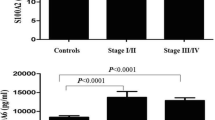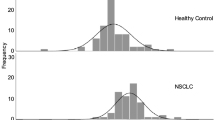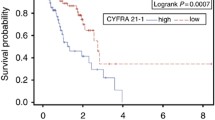Abstract
Objective
This study primarily aimed to analyze the levels of THBS2 in the serum of patients diagnosed with non-small cell lung cancer (NSCLC), and subsequently evaluate its potential as a diagnostic biomarker for NSCLC.
Methods
Serum samples were collected from 150 diagnosed NSCLC patients and 150 healthy individuals. The THBS2 concentration in these samples was determined using an enzyme-linked immunosorbent assay (ELISA). The study also investigated the correlation between THBS2 levels and various clinicopathological characteristics in NSCLC patients. The diagnostic sensitivity and specificity of serum THBS2 for NSCLC were assessed using receiver operating characteristic (ROC) curves and their corresponding area under the curve (AUC).
Results
Serum THBS2 levels in NSCLC patients were significantly elevated compared to those in healthy individuals. THBS2 levels showed a significant correlation with tumor differentiation grade, tumor size, TNM stage, lymph node metastasis, and distant metastasis. No significant correlation was identified between serum THBS2 levels and other parameters such as gender, age, height, weight, BMI, smoking history, and tumor histological type. At a cutoff value of 7.62 ng/mL, THBS2 could effectively differentiate NSCLC patients from healthy individuals, with a sensitivity of 85.31% and a specificity of 88.92%. The AUC for NSCLC diagnosis using THBS2 was 0.812, significantly surpassing the performance of traditional tumor markers tested, including CEA (0.728), and CYFRA 21‑1 (0.685).
Conclusions
Elevated serum THBS2 levels in NSCLC patients suggest its potential as a novel and reliable diagnostic biomarker for NSCLC. Its superior diagnostic performance could potentially outperform traditional tumor markers, leading to improved patient outcomes.



Similar content being viewed by others
Data availability
Any researchers can access to the datasets by contacting the corresponding author and providing recommendations concerning non-commercial use and privacy protection from their institutions.
References
Bao Y, Yan E, Wang N (2023) Evaluation of GREM1 and THBS2 as prognostic markers in in non-small cell lung cancer. J Cancer Res Clin Oncol 149(10):7849–7856
Calabro NE, Kristofik NJ, Kyriakides TR (2014) Thrombospondin-2 and extracellular matrix assembly. Biochim Biophys Acta 1840(8):2396–2402
Cedres S, Nunez I, Longo M et al (2011) Serum tumor markers CEA, CYFRA21-1, and CA-125 are associated with worse prognosis in advanced non-small-cell lung cancer (NSCLC). Clin Lung Cancer 12(3):172–179
Chen L, Li Y, Lu J (2020) Identification of Circulating miR-762 as a Novel Diagnostic and Prognostic Biomarker for Non-Small Cell Lung Cancer. Technol Cancer Res Treat 19:1533033820964222
Fei W, Chen L, Chen J et al (2017) RBP4 and THBS2 are serum biomarkers for diagnosis of colorectal cancer. Oncotarget 8(54):92254–92264
Gao Y, Song P, Li H et al (2017) Elevated serum CEA levels are associated with the explosive progression of lung adenocarcinoma harboring EGFR mutations. BMC Cancer 17(1):484
Ge T, Zhou Y, Lu H (2019) The diagnostic performance of lysine(K)-specific demethylase 6B (KDM6B) in non-small cell lung cancer. Artif Cells Nanomed Biotechnol 47(1):2155–2160
Gijtenbeek RG, de Jong K, Venmans BJ et al (2023) Best first-line therapy for people with advanced non-small cell lung cancer, performance status 2 without a targetable mutation or with an unknown mutation status. Cochrane Database Syst Rev 7(7):CD013382
Goto M, Naito M, Saruwatari K et al (2017) The ratio of cancer cells to stroma after induction therapy in the treatment of non-small cell lung cancer. J Cancer Res Clin Oncol 143(2):215–223
Hang D, Zhou J, Qin N et al (2018) A novel plasma circular RNA circFARSA is a potential biomarker for non-small cell lung cancer. Cancer Med 7(6):2783–2791
Hong G, Sun P, Chung C et al (2023) Plasma GDF15 levels associated with circulating immune cells predict the efficacy of PD-1/PD-L1 inhibitor treatment and prognosis in patients with advanced non-small cell lung cancer. J Cancer Res Clin Oncol 149(1):159–171
Jiang M, Chen P, Guo X et al (2023) Identification of EGFR mutation status in male patients with non-small-cell lung cancer: role of (18)F-FDG PET/CT and serum tumor markers CYFRA21-1 and SCC-Ag. EJNMMI Res 13(1):27
Kim J, Bamlet WR, Oberg AL et al (2017) Detection of early pancreatic ductal adenocarcinoma with thrombospondin-2 and CA19–9 blood markers. Sci Transl Med 9(398). https://doi.org/10.1126/scitranslmed.aah5583
Liu L, Liu B, Zhu LL et al (2012) Clinical significance of CYFRA21-1, Scc-Ag and telomerase activity in serum and pleural effusion of patients with squamous-cell lung cancer. Bioanalysis 4(19):2367–2374
Liu L, Liu B, Zhu LL et al (2013) CYFRA21-1 as a serum tumor marker for follow-up patients with squamous cell lung carcinoma and oropharynx squamous cell carcinoma. Biomark Med 7(4):591–599
Matsuoka K, Sumitomo S, Nakashima N et al (2007) Prognostic value of carcinoembryonic antigen and CYFRA21-1 in patients with pathological stage I non-small cell lung cancer. Eur J Cardiothorac Surg 32(3):435–439
Melling N, Reeh M, Ghadban T et al (2023) RAI3 expression is not associated with clinical outcomes of patients with non-small cell lung cancer. J Cancer Res Clin Oncol 149:6549–6555. https://doi.org/10.1007/s00432-023-04631-3
Mithoowani H, Febbraro M (2022) Non-Small-Cell Lung Cancer in 2022: A Review for General Practitioners in Oncology. Curr Oncol 29(3):1828–1839
Myall NJ, Das M (2020) Advances in the Treatment of Stage III Non-Small Cell Lung Cancer. Clin Chest Med 41(2):211–222
Nicholson AG, Tsao MS, Beasley MB et al (2022) The 2021 WHO Classification of Lung Tumors: Impact of Advances Since 2015. J Thorac Oncol 17(3):362–387
Patel KH, Alpert N, Tuminello S et al (2023) Personal and clinical characteristics associated with immunotherapy effectiveness in stage IV non-small cell lung cancer. Transl Lung Cancer Res 12(6):1210–1220
Ren L, Yang Y (2023) Value of dual-source CT dual-energy parameters combined with serum detection of VEGF and CEA in the diagnosis of early lung cancer. Biotechnol Genet Eng Rev 19:1–12
Sakao Y, Tomimitsu S, Takeda Y et al (2004) Carcinoembryonic antigen as a predictive factor for postoperative tumor relapse in early-stage lung adenocarcinoma. Eur J Cardiothorac Surg 25(4):520–522
Sung H, Ferlay J, Siegel RL et al (2021) Global Cancer Statistics 2020: GLOBOCAN Estimates of Incidence and Mortality Worldwide for 36 Cancers in 185 Countries. CA Cancer J Clin 71(3):209–249
Thomas M, Hoffknecht P, Droege C et al (2004) Non-small-cell lung cancer: multimodality approach in stage-III resectable disease. Lung Cancer 45(2):S99-105
Tomita M, Matsuzaki Y, Edagawa M et al (2004) Prognostic significance of preoperative serum carcinoembryonic antigen level in lung adenocarcinoma but not squamous cell carcinoma. Ann Thorac Cardiovasc Surg 10(2):76–80
Udgata S, Takenaka N, Bamlet WR et al (2021) THBS2/CA19-9 Detecting Pancreatic Ductal Adenocarcinoma at Diagnosis Underperforms in Prediagnostic Detection: Implications for Biomarker Advancement. Cancer Prev Res (phila) 14(2):223–232
Wang X, Zhang L, Li H et al (2016) THBS2 is a Potential Prognostic Biomarker in Colorectal Cancer. Sci Rep 16(6):33366
Wang L, Feng L, Liu L et al (2023) Joint effect of THBS2 and VCAN accelerating the poor prognosis of gastric cancer. Aging (albany, NY) 15(5):1343–1357
Weng TY, Wang CY, Hung YH et al (2016) Differential Expression Pattern of THBS1 and THBS2 in Lung Cancer: Clinical Outcome and a Systematic-Analysis of Microarray Databases. PLoS ONE 11(8):e0161007
Xu CH, Wang W, Wang YC et al (2018) Diagnosis value of serum soluble B7–H4 expression in non-small cell lung cancer. Clin Respir J 12(1):134–139
Xu C, Liu W, Li L et al (2021) Serum tumour M2-pyruvate kinase as a biomarker for diagnosis and prognosis of early-stage non-small cell lung cancer. J Cell Mol Med 25(15):7335–7341
Yuan B, Ji W, Fan B et al (2018) Association analysis between thrombospondin-2 gene polymorphisms and intervertebral disc degeneration in a Chinese Han population. Medicine (baltimore) 97(2):e9586
Zhang Q, Qin S, Peng C et al (2023) Circulating circular RNA hsa_circ_0023179 acts as a diagnostic biomarker for non-small-cell lung cancer detection. J Cancer Res Clin Oncol 149(7):3649–3660
Acknowledgements
We would like to thank the study subjects for their participation in the work.
Funding
No funding supported this work.
Author information
Authors and Affiliations
Contributions
LX and CZ conceived the idea and conceptualized the study. YL collected and analysed the data. MC and ML drafted and revised the manuscript. All authors have read and approved the manuscript.
Corresponding authors
Ethics declarations
Conflict of interest
The authors declare that they have no conflict of interests.
Ethical approval
The study complied with the Declaration of Helsinki and was approved by the ethical committee of The First Affiliated Hospital of Chengdu Medical College (No. 20823574). Every participant gave their informed written consent to participate in the study.
Consent for publication
Every participant gave their consent for publication of this work.
Additional information
Publisher's Note
Springer Nature remains neutral with regard to jurisdictional claims in published maps and institutional affiliations.
Rights and permissions
Springer Nature or its licensor (e.g. a society or other partner) holds exclusive rights to this article under a publishing agreement with the author(s) or other rightsholder(s); author self-archiving of the accepted manuscript version of this article is solely governed by the terms of such publishing agreement and applicable law.
About this article
Cite this article
Xiong, L., Zhu, C., Lu, Y. et al. Serum THBS2 is a potential biomarker for the diagnosis of non-small cell lung cancer. J Cancer Res Clin Oncol 149, 15671–15677 (2023). https://doi.org/10.1007/s00432-023-05330-9
Received:
Accepted:
Published:
Issue Date:
DOI: https://doi.org/10.1007/s00432-023-05330-9




